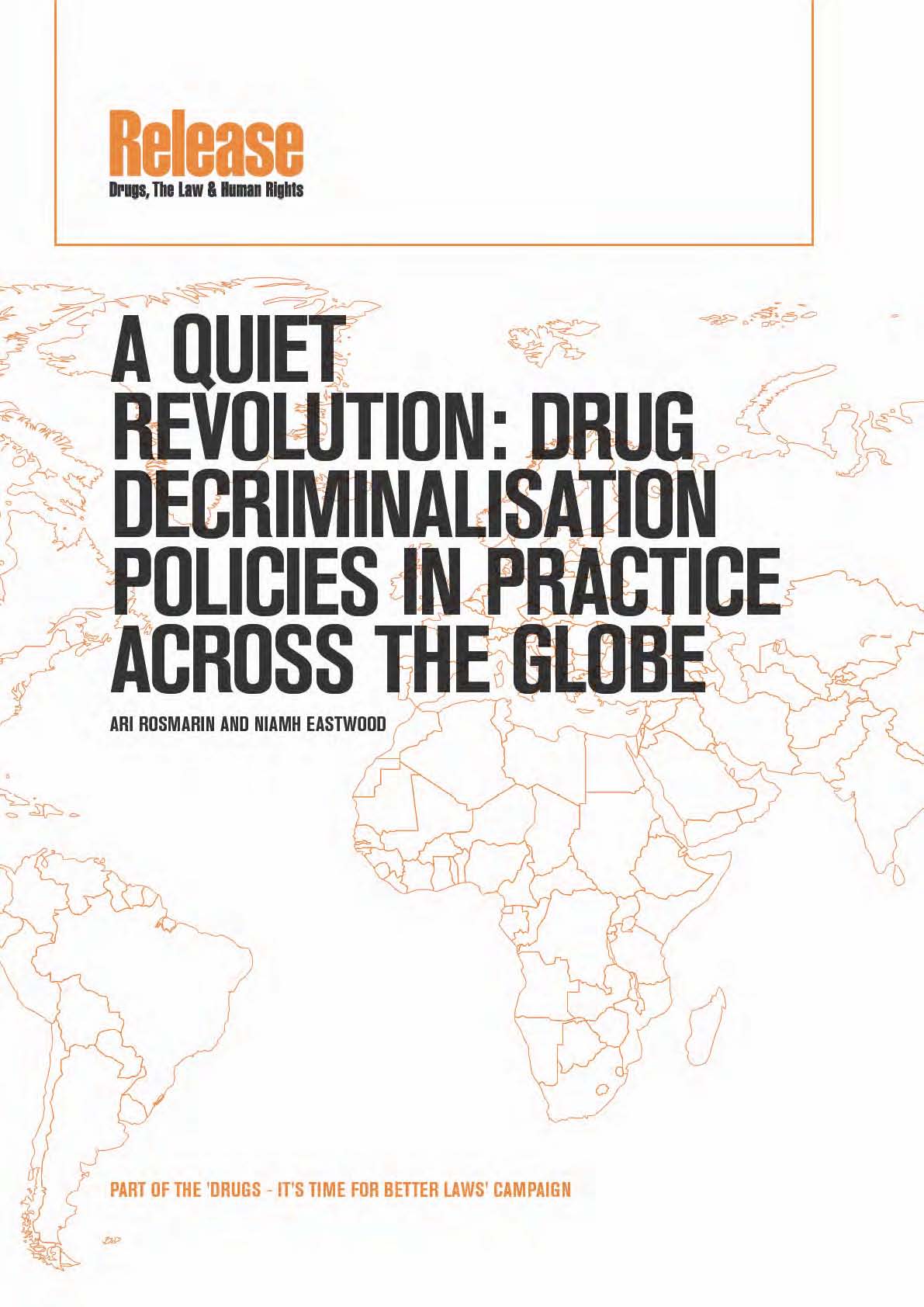Connolly, Johnny
(2013)
Approaches to drug decriminalisation in disparate countries.
Drugnet Ireland,
Issue 45, Spring 2013,
p. 14.
As part of its campaign, ‘Drugs – it’s time for better laws’, the UK-based advocacy group Release has published a report, A quiet revolution: drug decriminalisation policies in practice across the globe.1 The report identifies a trend over the past decade towards the decriminalisation of drug possession and use, suggesting a ‘growing recognition of the failures of the criminalisation approach and a strengthening political wind blowing in the direction of an historic paradigm shift’ (p.9).

Although the decriminalisation of drug possession and use in Portugal in 2001 has attracted a good deal of attention throughout Europe,2 the report shows that the trend towards decriminalisation has not been centred in one continent or in richer or poorer nations: ‘Countries as disparate as Armenia, Belgium, Chile, the Czech Republic, Estonia, Mexico’ have all adopted some form of decriminalisation (p.9). The report describes and assesses decriminalisation approaches in 21 countries. It presents case studies from jurisdictions that have adopted ‘good models of decriminalisation and those that have adopted what could be described as hollow examples’ where ‘the possession thresholds are so low that the system is effectively unenforceable and most people are criminalised’ (p.13).
The decriminalisation policies and models adopted in different countries are extremely varied, which renders an assessment of their impact quite challenging. The impact of decriminalisation on such factors as ‘prevalence of drug use, problematic drug use, drug-related disease and death, and criminal justice costs’ is complicated by the wide range of policy variables adopted in different countries (p.10). These variables include the following:
· Threshold quantities: Many policies use maximum-quantity thresholds to distinguish between trafficking and personal possession offences. For example, ‘Mexico allows possession of up to 0.5 grams of cocaine without prosecution, while Spain allows up to 7.5 grams – a difference of 1400%’.
· Types of administrative penalties: Different sanctions for possession offences may include ‘fines, community-service orders, warnings, education classes, suspension of a driver’s licence…travel bans…administrative arrest, or no penalty at all’.
· Roles of the judiciary and police: Some jurisdictions allow the police to issue an ‘on the spot’ penalty while others require the offender to appear before a judge.
· The role of medical professionals and harm reduction programmes: Some countries, such as Portugal, have integrated public health and law enforcement systems so that offenders appear before a panel that includes medical professionals for an assessment of their treatment needs.
· Records and statistics-measurement capacity: The availability and quality of data in the system can determine the ‘assessment of the impact of a decriminalisation policy’.
· Implementation challenges: The introduction of a decriminalisation policy in law can be undermined and effectively neutralised where law enforcement refuses to apply it in practice. The report gives the example of New York where possession of one ounce of marijuana is not a crime unless the drug is ‘burning or in open view’. However, it is reported that police officers ‘often trick young people…into revealing the marijuana; thus the offence is committed as the drug is in “open view” ’ (p.11). The authors state that this practice ‘has led to a significant increase in arrests, with 50,300 people arrested for simple marijuana possession in 2010 alone compared to a total of 33,700 for the period 1981 to 1995’ (p.11)
Despite these many policy variables however, the report does offer a number of broad observations. Acknowledging that ‘decriminalisation is not a panacea’ for problematic drug use, it states that ‘a country’s drug enforcement policies appear to have but a minor effect on the impact of drugs in a society. … Decriminalisation does appear to direct more users into treatment, reduce criminal costs, and shield many drug users from the devastating impact of a criminal conviction’ (p.12).
Based on the case studies provided in this report, the authors conclude that ‘governments and academics must invest more in researching which policy models are the most effective in reducing drug harms and achieving just and healthy policy outcomes’. In proposing such an evidence-based approach, they state that ‘more and better data will bolster the existing research and provide a sound foundation on which to build and design drug policies of the future’ (p.40).
Although drug law reform has never been high on the political agenda in Ireland, a recent policy document launched by the CityWide Drugs Crisis Campaign calls for a debate on drug decriminalisation.3 Topics for such a debate include the view that ‘much of the harm related to drug use and drug dealing occurs because of their illicit nature’ and that ‘the global war on drugs has failed and it is time for us to challenge rather than reinforce common misconceptions about drug markets, drug use and drug dependence’ (p.5)
1. Rosmarin A and Eastwood N (2012)
A quiet revolution: drug decriminalisation policies in practice across the globe. London: Release.
www.drugsandalcohol.ie/183272. Connolly J (2009) Reports examine effects of decriminalisation of drugs in Portugal.
Drugnet Ireland, 30: 22–23.
www.drugsandalcohol.ie/122043. Higgins M (2012)
The drugs crisis in Ireland: a new agenda for action.
CityWide policy statement February 2012. Dublin: CityWide.
www.drugsandalcohol.ie/17145